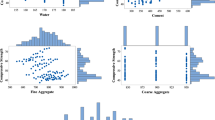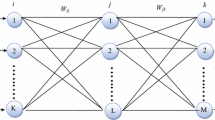Abstract
Understanding the mechanical behaviour of impregnated wood is crucial in making a preliminary decision on the usability of such woods for structural purposes. In this paper, by considering concentration (1, 3 and 5%), pressure (1, 1.5 and 2 atm.), and time (30, 60, 90 and 120 min), an experimental study was performed, and the mechanical behaviour of impregnated wood was determined as a result of the experimental process. Multiple adaptive regression splines (MARS), teaching–learning based optimization (TLBO) algorithms and conventional regression analysis (CRA) were applied to different regression functions by using experimentally obtained data. The functions were checked against each other to detect the best equation for each parameter and to assess performances of MARS, TLBO and CRA methods in the prediction of mechanical properties. The experimental results showed that higher values of mechanical properties were obtained when lower concentration, pressure and time were chosen. Overall, all the functions successfully predicted the mechanical properties. However, the MARS and TLBO provided better accuracy in predicting the mechanical properties. The modeling results indicated that the MARS and TLBO are promising new methods in predicting the mechanical properties of impregnated wood. With the use of these methods, the mechanical behavior of impregnated wood could be determined with high levels of accuracy. Thus, the proposed methods may facilitate a preliminary decision concerning the usability of such woods for areas where the mechanical properties are important. Finally, the employment of MARS and TLBO algorithms by practitioners in the wood industry is encouraged and recommended for future studies.




Similar content being viewed by others
References
Amiri B (2012) Application of teaching–learning-based optimization algorithm on cluster analysis. J Basic Appl Sci Res 2(11):11795–11802
ASTM D 1413 (1976) Standard test method of testing wood preservatives by laboratory soil block cultures, 1976: annual book of ASTM standards, USA, pp 452–460
Bas D, Boyacı IH (2007) Modeling and optimization I: usability of response surface methodology. J Food Eng 78:836–845
Bayram A, Uzlu E, Kankal M, Dede T (2015) Modeling stream dissolved oxygen concentration using teaching–learning based optimization algorithm. Environ Earth Sci 73:6565–6576
Baysal E, Yalinkilic MK (2005) A new boron impregnation technique of wood by vapor boron of boric acid to reduce leaching boron from wood. Wood Sci Technol 39:187–198
Behzad HM, Ashori A, Tarmian A, Tajvidi M (2012) Impacts of wood preservative treatments on some physico-mechanical properties of wood flour/high density polyethylene composites. Const Build Mater 35:246–250
Chen T, Hong Z, F-a Deng, Yang X, Wei J, Cui M (2015) A novel selective ensemble classification of microarray data based on teaching-learning-based optimization. Int J Multimed Ubiquitous Eng 10(6):203–218
Cheng MY, Cao MT (2014) Evolutionary multivariate adaptive regression splines for estimating shear strength in reinforced-concrete deep beams. Eng Appl Artif Intell 28:86–96
Das SK, Suman S (2015) Prediction of lateral load capacity of pile in clay using multivariate adaptive regression spline and functional network. Arab J Sci Eng 40(6):1565–1578
Dede T (2013) Optimum design of grillage structures to LRFD-AISC with teaching–learning based optimization. Struct Multidisc Optim 48:955–964
Değirmentepe S, Baysal E, Türkoğlu T, Toker H, Deveci E (2015) Some properties of Turkish sweetgum balsam (Styrax Liquidus) impregnated oriental beech wood part II: decay resistance, mechanical, and thermal properties. Wood Res 60(4):591–604
Deo RC, Kisi O, Singh VP (2017) Drought forecasting in eastern Australia using multivariate adaptive regression spline, least square support vector machine and M5Tree model. Atmos Res 184:149–175
Dey P, Das AK (2016) Application of multivariate adaptive regression spline-assisted objective function on optimization of heat transfer rate around a Cylinder. Nucl Eng Technol 48:1315–1320
Eslah F, Enayati AA, Tajvidi M, Faezipour MM (2012) Regression models for the prediction of poplar particleboard properties based on urea formaldehyde resin content and board density. J Agric Sci Tech 14:1321–1329
Esteban LG, Fernández FG, de Palacios P, Conde M (2009) Artificial neural networks in variable process control: application in particleboard manufacture. Invest Agrar Sist Recur For 18(1):92–100
Fernandez FG, Esteban LG, de Palacios P, Navarro N, Conde M (2008) Prediction of standard particleboard mechanical properties utilizing an artificial neural network and subsequent comparison with a multivariate regression model. Invest Agrar Sist R 17:178–187
Fernandez FG, DePalacios P, Esteban LG, Iruela AG, Rodrigo BG, Menasalvas E (2012) Prediction of MOR and MOE of structural plywood board using an artificial neural network and comparison with a multivariate regression model. Compos B 43:3528–3533
Friedman JH (1991) Multivariate adaptive regression splines (with Discussion). Ann Stat 19(1):1–141
Hashemi SKH, Latibari AJ, Khademi-Eslam H, Alamuti RF (2010) Effect of boric acid treatment on decay resistance and mechanical properties of poplar wood. BioResources 5(2):690–698
Kecebas A, Yabanova I, Yumurtaci M (2012) Artificial neural network modeling of geothermal district heating system thought exergy analysis. Energy Convers Manage 64:206–212
Khuntia S, Mujtaba H, Patra C, Farooq K, Sivakugan N, Das BM (2015) Prediction of compaction parameters of coarse grained soil using multivariate adaptive regression splines (MARS). Int J Geotech Eng 9(1):79–88
Lin WW, Yu DY, Wang S, Zhang CY, Zhang SQ, Tian HY et al (2015) Multi-objective teaching–learning-based optimization algorithm for reducing carbon emissions and operation time in turning operations. Eng Optim 47:994–1007
Ozciftci A, Ayar S, Baysal E, Toker H (2011) The effects of some impregnation parameters on modulus of rupture and modulus of elasticity of wood. Wood Res 56(2):277–284
Pawar PJ, Rao RV (2013) Parameter optimization of machining processes using teaching–learning-based optimization algorithm. Int J Adv Manuf Technol 67:995–1006
Rao RV, More KC (2015) Optimal design of the heat pipe using TLBO (teaching–learning-based optimization) algorithm. Energy 80:535–544
Rao RV, Savsani VJ, Vakharia DP (2011) Teaching–learning-based optimization: a novel method for constrained mechanical design optimization problems. Comput Aided Des 43:303–315
Rao RV, Savsani VJ, Vakharia DP (2012) Teaching–learning-based optimization: an optimization method for continuous non-linear large scale problems. Inform Sci 183:1–15
Roy PK (2013) Teaching learning based optimization for short-term hydrothermal scheduling problem considering valve point effect and prohibited discharge constraint. Int J Elect Power Energy Syst 53:10–19
Samui P (2013) Multivariate adaptive regression spline (MARS) for prediction of elastic modulus of jointed rock mass. Geotech Geol Eng 31:249–253
Shanu SA, Das AK, Rahman MM, Ashaduzzaman M (2015) Effect of chromate–copper–boron preservative treatment on physical and mechanical properties of Raj koroi (Albizia richardiana) wood. Bangladesh J Sci Ind Res 50(3):189–192
Sharda VN, Patel RM, Prasher SO, Ojasvi PR, Prakash C (2006) Modeling runoff from middle Himalayan watersheds employing artificial intelligence techniques. Agric Water Manage 83:233–242
Simsek H, Baysal E (2015) Some physical and mechanical properties of borate-treated oriental beech wood. Drvna Ind 66(2):97–103
Suman S, Khan SZ, Das SK, Chand SK (2016) Slope stability analysis using artificial intelligence techniques. Nat Hazards 84(20):727–748
Tan H, Ulusoy H, Peker H (2017) The effects of impregnation with barite (BaSO4) on the physical and mechanical properties of wood materials. J Bartin Faculty For 19(2):160–165
Tiryaki S, Hamzacebi C (2014) Predicting modulus of rupture (MOR) and modulus of elasticity (MOE) of heat treated woods by artificial neural networks. Measurement 49:266–274
Tiryaki S, Bardak S, Bardak T (2015) Experimental investigation and prediction of bonding strength of Oriental beech (Fagus orientalis Lipsky) bonded with polyvinyl acetate adhesive. J Adhes Sci Technol 29(23):2521–2536
Togan V (2013) Design of pin jointed structures using teaching-learning based optimization. Struct Eng Mech 47(2):209–225
Toker H, Baysal E, Simsek H, Senel A, Sonmez A, Altinok M, Ozcifci A, Yapıcı F (2009) Effects of some environmentally-friendly fire-retardant boron compounds on modulus of rupture and modulus of elastıcıty of wood. Wood Res 54(1):77–88
Tomak ED, Viitanen H, Yildiz UC, Hughes M (2011) The combined effects of boron and oil heat treatment on the properties of beech and Scots pine wood. Part 2: water absorption, compression strength, color changes, and decay resistance. J Mater Sci 46(3):608–615
TS 2474 (1976) Wood-determination of ultimate strength in static bending. Institute of Turkish Standards, Ankara
TS 2595 (1977) Wood-testing in compression parallel to grain. Institute of Turkish Standards, Ankara
Uluer O, Kırmacı V, Atas S (2009) Using the artificial neural network model for modeling the performance of the counter flow vortex tube. Expert Syst Appl 36:12256–12263
Uzlu E, Kömürcü Mİ, Kankal M, Dede T, Öztürk HT (2014) Prediction of berm geometry using a set of laboratory tests combined with teaching–learning-based optimization and artificial bee colony algorithms. Appl Ocean Res 48:103–113
Villasante A, Laina R, Rojas JAM, Rojas IM, Vignote S (2013) Mechanical properties of wood from Pinus sylvestris L. treated with light organic solvent preservative and with waterbone copper azole. For Syst 22(3):416–422
Winandy JE (1995) The effects of waterborne preservative treatment on mechanical properties: a review. Proc Am Wood Preservers’ Assoc Woodstock MD 91:17–33
Xia K, Gao L, Li W, Chao KM (2014) Disassembly sequence planning using a simplified teaching–learning-based optimization algorithm. Adv Eng Inf 28:518–527
Yang H, Cheng W, Han G (2015) Wood modification at high temperature and pressurized steam: a relational model of mechanical properties based on a neural network. BioResources 10(3):5758–5776
Yapıcı F, Ulucan D (2012) Prediction of modulus of rupture and modulus of elasticity of heat treated Anatolian chestnut (Castanea sativa) wood by fuzzy logic classifier. Drvna Ind 63:37–43
Yildiz UC, Temiz A, Gezer ED, Yildiz S (2004) Effects of the wood preservatives on mechanical properties of yellow pine (Pinus sylvestris L.) wood. Build Environ 39:1071–1075
Zhang W, Goh ATC (2016) Multivariate adaptive regression splines and neural network models for prediction of pile drivability. Geosci Front 7:45–52
Author information
Authors and Affiliations
Corresponding author
Additional information
Publisher’s Note
Springer Nature remains neutral with regard to jurisdictional claims in published maps and institutional affiliations.
Rights and permissions
About this article
Cite this article
Tiryaki, S., Tan, H., Bardak, S. et al. Performance evaluation of multiple adaptive regression splines, teaching–learning based optimization and conventional regression techniques in predicting mechanical properties of impregnated wood. Eur. J. Wood Prod. 77, 645–659 (2019). https://doi.org/10.1007/s00107-019-01416-9
Received:
Published:
Issue Date:
DOI: https://doi.org/10.1007/s00107-019-01416-9




